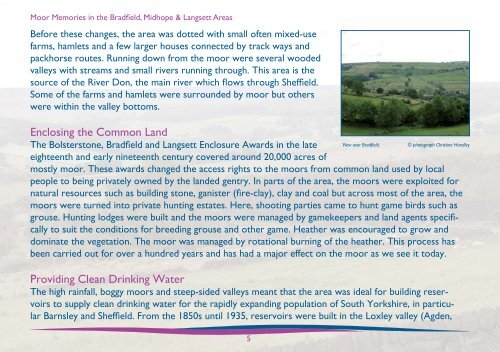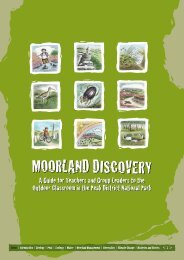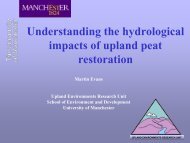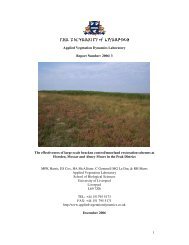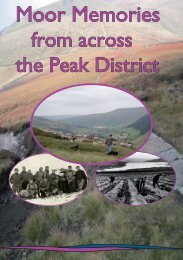Hills, Dykes and Dams - Moors for the Future
Hills, Dykes and Dams - Moors for the Future
Hills, Dykes and Dams - Moors for the Future
- No tags were found...
You also want an ePaper? Increase the reach of your titles
YUMPU automatically turns print PDFs into web optimized ePapers that Google loves.
Moor Memories in <strong>the</strong> Bradfi eld, Midhope & Langsett AreasBe<strong>for</strong>e <strong>the</strong>se changes, <strong>the</strong> area was dotted with small often mixed-usefarms, hamlets <strong>and</strong> a few larger houses connected by track ways <strong>and</strong>packhorse routes. Running down from <strong>the</strong> moor were several woodedvalleys with streams <strong>and</strong> small rivers running through. This area is <strong>the</strong>source of <strong>the</strong> River Don, <strong>the</strong> main river which fl ows through Sheffi eld.Some of <strong>the</strong> farms <strong>and</strong> hamlets were surrounded by moor but o<strong>the</strong>rswere within <strong>the</strong> valley bottoms.Enclosing <strong>the</strong> Common L<strong>and</strong>The Bolsterstone, Bradfi eld <strong>and</strong> Langsett Enclosure Awards in <strong>the</strong> lateeighteenth <strong>and</strong> early nineteenth century covered around 20,000 acres ofmostly moor. These awards changed <strong>the</strong> access rights to <strong>the</strong> moors from common l<strong>and</strong> used by localpeople to being privately owned by <strong>the</strong> l<strong>and</strong>ed gentry. In parts of <strong>the</strong> area, <strong>the</strong> moors were exploited <strong>for</strong>natural resources such as building stone, ganister (fi re-clay), clay <strong>and</strong> coal but across most of <strong>the</strong> area, <strong>the</strong>moors were turned into private hunting estates. Here, shooting parties came to hunt game birds such asgrouse. Hunting lodges were built <strong>and</strong> <strong>the</strong> moors were managed by gamekeepers <strong>and</strong> l<strong>and</strong> agents specifi -cally to suit <strong>the</strong> conditions <strong>for</strong> breeding grouse <strong>and</strong> o<strong>the</strong>r game. Hea<strong>the</strong>r was encouraged to grow <strong>and</strong>dominate <strong>the</strong> vegetation. The moor was managed by rotational burning of <strong>the</strong> hea<strong>the</strong>r. This process hasbeen carried out <strong>for</strong> over a hundred years <strong>and</strong> has had a major effect on <strong>the</strong> moor as we see it today.Providing Clean Drinking WaterThe high rainfall, boggy moors <strong>and</strong> steep-sided valleys meant that <strong>the</strong> area was ideal <strong>for</strong> building reservoirsto supply clean drinking water <strong>for</strong> <strong>the</strong> rapidly exp<strong>and</strong>ing population of South Yorkshire, in particularBarnsley <strong>and</strong> Sheffi eld. From <strong>the</strong> 1850s until 1935, reservoirs were built in <strong>the</strong> Loxley valley (Agden,5View over Bradfi eld. © photograph Christine H<strong>and</strong>ley


